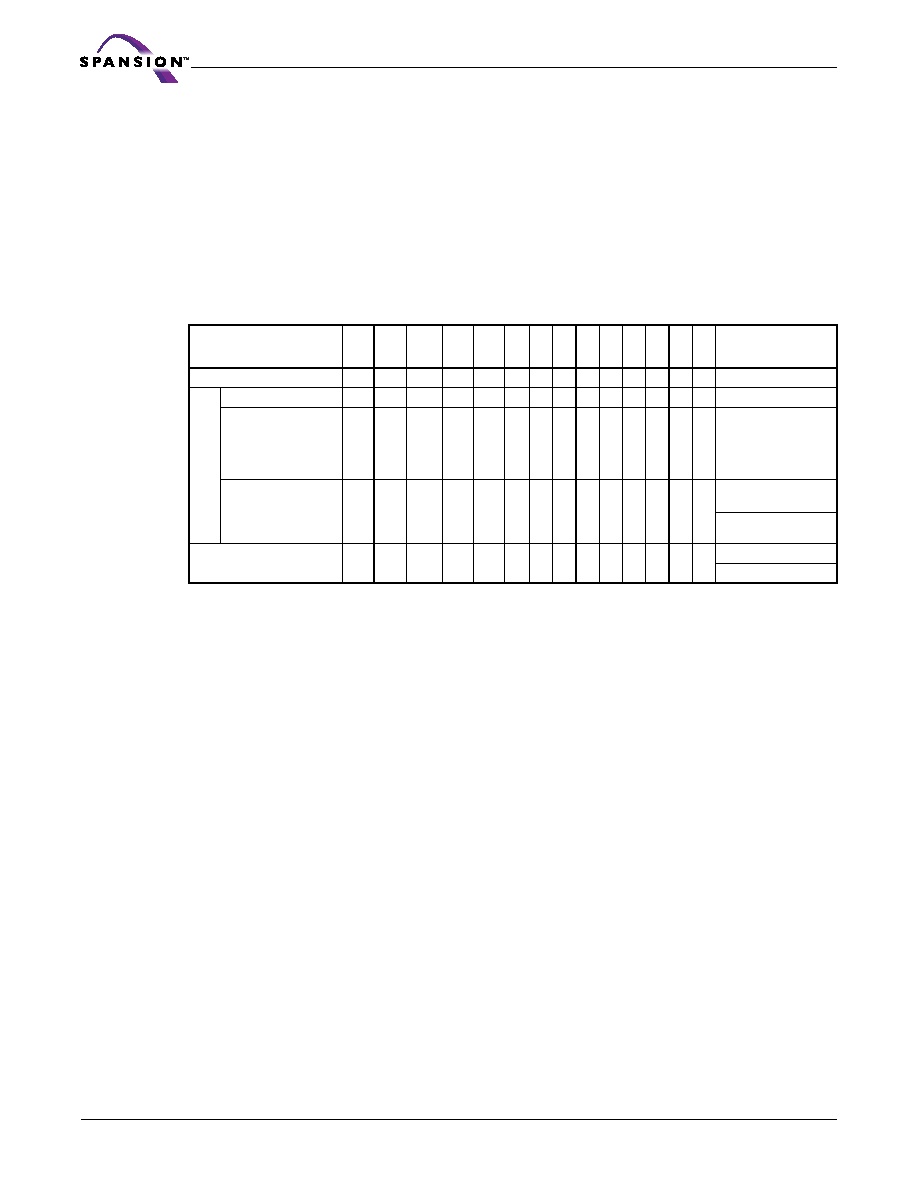- 您現(xiàn)在的位置:買(mǎi)賣(mài)IC網(wǎng) > PDF目錄192296 > S29CL016J0PFFM102 (SPANSION LLC) 512K X 32 FLASH 3.3V PROM, 54 ns, PBGA80 PDF資料下載
參數(shù)資料
| 型號(hào): | S29CL016J0PFFM102 |
| 廠商: | SPANSION LLC |
| 元件分類(lèi): | PROM |
| 英文描述: | 512K X 32 FLASH 3.3V PROM, 54 ns, PBGA80 |
| 封裝: | 13 X 11 MM, 1 MM PITCH, LEAD FREE, FORTIFIED, BGA-80 |
| 文件頁(yè)數(shù): | 24/78頁(yè) |
| 文件大小: | 1825K |
| 代理商: | S29CL016J0PFFM102 |
第1頁(yè)第2頁(yè)第3頁(yè)第4頁(yè)第5頁(yè)第6頁(yè)第7頁(yè)第8頁(yè)第9頁(yè)第10頁(yè)第11頁(yè)第12頁(yè)第13頁(yè)第14頁(yè)第15頁(yè)第16頁(yè)第17頁(yè)第18頁(yè)第19頁(yè)第20頁(yè)第21頁(yè)第22頁(yè)第23頁(yè)當(dāng)前第24頁(yè)第25頁(yè)第26頁(yè)第27頁(yè)第28頁(yè)第29頁(yè)第30頁(yè)第31頁(yè)第32頁(yè)第33頁(yè)第34頁(yè)第35頁(yè)第36頁(yè)第37頁(yè)第38頁(yè)第39頁(yè)第40頁(yè)第41頁(yè)第42頁(yè)第43頁(yè)第44頁(yè)第45頁(yè)第46頁(yè)第47頁(yè)第48頁(yè)第49頁(yè)第50頁(yè)第51頁(yè)第52頁(yè)第53頁(yè)第54頁(yè)第55頁(yè)第56頁(yè)第57頁(yè)第58頁(yè)第59頁(yè)第60頁(yè)第61頁(yè)第62頁(yè)第63頁(yè)第64頁(yè)第65頁(yè)第66頁(yè)第67頁(yè)第68頁(yè)第69頁(yè)第70頁(yè)第71頁(yè)第72頁(yè)第73頁(yè)第74頁(yè)第75頁(yè)第76頁(yè)第77頁(yè)第78頁(yè)

28
S29CD-J & S29CL-J Flash Family
S29CD-J_CL-J_00_B1 September27,2006
Prel imi n ary
shows the remaining address bits that are don’t care. When all necessary bits have been set as
required, the programming equipment may then read the corresponding identifier code on DQ7–
DQ0.
In order to access the autoselect codes in-system, the host system can issue the autoselect com-
mand via the command. This method does not require VID. See Command Definitions on
page 71 for details on using the autoselect mode. Autoselect mode can be used in either syn-
chronous (Burst) mode or asynchronous (Non Burst) mode.
The system must write the reset command to exit the autoselect mode and return to reading the
array data. See Table 8.7 for command sequence details.
Legend: L = Logic Low = VIL, H = Logic High = VIH, SA = Sector Address, X = Don’t care.
Note: The autoselect codes can also be accessed in-system via command sequences. See Table 20.2.
8.6
VersatileI/O (VIO) Control
The VersatileI/O (VIO) control allows the host system to set the voltage levels that the device
generates at its data outputs and the voltages tolerated at its data inputs to the same voltage
level that is asserted on the VIO pin. The output voltage generated on the device is determined
based on the VIO (VCCQ) level. For the 2.6 V (CD-J), a VIO of 1.65 V - 3.6 V (CD032J has a VIO
of 1.65V to 2.75V) allows the device to interface with I/Os lower than 2.5 V. For a 3.3 V VCC (CL-
J), a VIO of 1.65 V-3.60 V allows the device to interface with I/Os lower than 3.0 V.
8.7
Program/Erase Operations
These devices are capable of several modes of programming and or erase operations which are
described in detail in the following sections. However, prior to any programming and or erase
operation, devices must be set up appropriately as outlined in the configuration register
(Table 8.5 on page 27). During a synchronous write operation, to write a command or command
sequence (including programming data to the device and erasing sectors of memory), the sys-
tem must drive AVD# and CE# to VIL, and OE# to VIH when providing an address to the device,
and drive WE# and CE# to VIL, and OE# to VIH when writing commands or programming data.
8.7.1
Programming
Programming is a four-bus-cycle operation. The program command sequence is initiated by writ-
ing two unlock write cycles, followed by the program setup command. The program address and
data are written next, which in turn initiate the Embedded Program algorithm. The system is not
Table 8.7 S29CD-J & S29CL-J Flash Family Autoselect Codes (High Voltage Method)
Description
CE# OE# WE#
A19
to
A11
A10 A9 A8 A7 A6
A5
to
A4
A3 A2 A1 A0
DQ7
to
DQ0
Manufacturer ID: Spansion
LL
H
X
VID X
X
L
X
L
0001h
Au
to
se
le
ct
De
vi
ce
Co
de
Read Cycle 1
LL
H
X
VID X
L
X
L
H
007Eh
Read Cycle 2
LL
H
X
VID X
LLL
H
L
08h or 36h for
CD016J
46h for CL016J
09h for CD032J
49h for CL032J
Read Cycle 3
LL
H
X
VID X
L
HHHH
0000h
Top Boot Option
0001h
Bottom Boot Option
PPB Protection Status
LL
H
SA
X
VID X
LLLLL
H
L
0000h (unprotected)
0001h (protected)
相關(guān)PDF資料 |
PDF描述 |
|---|---|
| S29CL016J1JFFM112 | 512K X 32 FLASH 3.3V PROM, 54 ns, PBGA80 |
| S29CD032J1JFAN110 | 1M X 32 FLASH 2.7V PROM, 54 ns, PBGA80 |
| S29CD032J1JFFN020 | 1M X 32 FLASH 2.7V PROM, 54 ns, PBGA80 |
| S29CL032J0RFAI113 | 1M X 32 FLASH 3.3V PROM, 48 ns, PBGA80 |
| S29CL032J0RFAN130 | 1M X 32 FLASH 3.3V PROM, 48 ns, PBGA80 |
相關(guān)代理商/技術(shù)參數(shù) |
參數(shù)描述 |
|---|---|
| S29CL016J1JFAI020 | 制造商:Spansion 功能描述:16 - Tape and Reel |
| S29CL032J0MFAI030 | 制造商:Spansion 功能描述:32MBIT FLASH - Trays |
| S29CL032J0PQFM010 | 制造商:Spansion 功能描述: 制造商:Spansion 功能描述:32MBIT FLASH - Tape and Reel |
| S29CL032J0RFAM010 | 制造商:Spansion 功能描述: |
| S29GL016A | 制造商:SPANSION 制造商全稱(chēng):SPANSION 功能描述:64 Megabit, 32 Megabit, and 16 Megabit 3.0-Volt only Page Mode Flash Memory Featuring 200 nm MirrorBit Process Technology |
發(fā)布緊急采購(gòu),3分鐘左右您將得到回復(fù)。